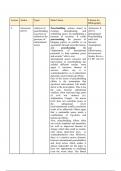Samenvatting
Readings Summary Introduction to Conflict Studies (Block 2)
- Vak
- (73210025IY)
- Instelling
- Universiteit Van Amsterdam (UvA)
Summary of all readings of the second block with citation and main topics covered, + some more detailed sections on humanitarian law, human rights law, and the ICC, for ease of access during the take-home exam
[Meer zien]




